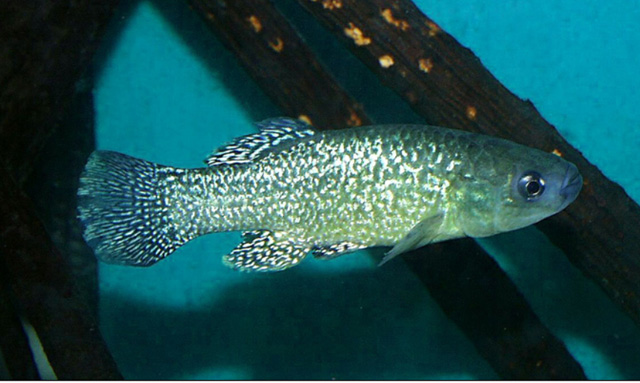| Fundulidae (Topminnows and killifishes) |
| 12.9 cm TL (male/unsexed); max.weight: 17.0 g; max.weight: 21.4 g |
|
benthopelagic; freshwater; brackish; marine, non-migratory |
| Western Central Atlantic: Endangered and endemic species found in Bermuda with highly fragmented populations and a very limited range (Ref. 59049).
Fundulus bermudae is believed to be a descendant of the Fundulus heteroclitus - F. grandis species group originating from populations on the east coast of North America (Ref. 59062). It is presently believed that none of the killifish ponds in Bermuda contain mixed populations of Fundulus bermudae and F. relictus. |
|
|
| A euryhaline species found only in a limited number of small, isolated fresh water, brackish water, and marine ponds (Ref. 59051). Recent study confines the distribution of this species to seven small, anchialine ponds in Bermuda (Ref. 59049). Total estimated population is 15,200 individuals in Mangrove Lake which is the largest anchialine pond in Bermuda (Ref. 59049). Non-annual killifish (Ref. 27139). May form loose schools consisting of equally sized individuals (Ref. 59051). An omnivorous fish, feeding on filamentous green algae, plant material, mollusks, crustaceans and insects (Ref. 59156). The main predators include a variety of birds (mostly herons), and fishes (eastern mosquito fish Gambusia holbrooki, gray snapper Lutjanus griseus, and American eel, Anguilla rostrata). Additionally, it is believed that the introduced and invasive red-eared terrapin Trachemys scripta elegans is a significant predator in a limited number of ponds (Ref. 59051). Spawning period occurs from February to September in Mangrove Lake, with primary peaks in May and June for males and females, respectively (Ref. 59049). |
|
Not Evaluated (N.E.) Ref. (130435)
|
| harmless |
|
Fundulus bermudae is endemic to the islands of Bermuda and is listed as a protected species in the Bermuda Protected Species Act 2003. Killifishes were described as abundant and widespread in the wetland communities of Bermuda during the late nineteenth and early twentieth centuries, but are now only found in nine small, isolated ponds. F. bermudae are found in seven of these ponds. Petersen population estimates (2004) are available for five of them. They are, in order of decreasing size; 11,325 fish (Mangrove Lake), 7,926 fish (Trott’s Pond), 5,394 fish (Blue Hole Bird Pond), 2,202 fish (West Walsingham Ponds), and 436 fish (Warwick Pond) (Ref. 59051). Local populations could include more undescribed Fundulus species (Ref. 35505).
In addition to six naturally occurring Fundulus bermudae populations in Bermuda, there is one other population living in a man-made pond, (created by dredging), where F. bermudae was intentionally introduced in the 1990s as a precaution against a possible extinction event. Additional translocations to other suitable ponds are planned in the near future. Also Ref. 27139. |
Source and more info: www.fishbase.org. For personal, classroom, and other internal use only. Not for publication.

